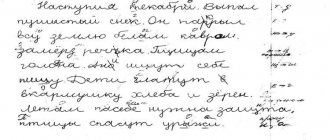Methods for identifying dysgraphia
Identification of dysgraphia is a complex process, which is based on solving the following problems:
- Distinguish an illness from ignorance of the rules of spelling words.
- Distinguish between this type of disorder and pathologies of the organs of vision, hearing, and ENT organs.
- Determine the form of the disease.
If there is a suspicion that a child has a pathology, you should consult with specialists:
- ophthalmologist - will see eye diseases and cerebral circulation disorders;
- otolaryngologist – examines for diseases of the throat, ears and nose;
- the dentist will see defects in the structure of the teeth, which may interfere with the correct pronunciation of words and indirectly contribute to their illiterate spelling;
- neurologist - will determine the state of the central nervous system and the problems existing in this area;
- speech therapist - will identify the presence of oral speech defects and their relationship with errors in writing, determine the type of dysgraphia.
The main stages of diagnosing dysgraphia are:
- Research of written works.
- Study of the patient’s physical, mental, speech development, condition of the organs of vision and hearing.
- Examination of the articular apparatus, manual and speech motor skills, determination of the dominant hand.
- Study of the level of sound perception, sound pronunciation, vocabulary of the child, knowledge and use of lexical and grammatical basics.
- Conducting a writing test.
Written language analysis involves identifying the disorder by presenting the child with various written tasks, after which a verdict is made. Types of written tasks for diagnosing dysgraphia: copying from handwritten and printed texts, describing pictures, dictations, tests.
In preschool children, the risk of subsequent problems with writing is identified by the quality of their drawings. Potential dysgraphics aged 3-6 years are drawn reluctantly, with uneven lines, abruptly, and unclearly. This is often due to undeveloped finger muscles and poorly developed hand motor skills.
What are the causes of dysgraphia?
The correct writing of words and the expression of one’s thoughts on paper largely depend on the correct formation of oral speech.
There are 2 groups of causes of dysgraphia:
- Diseases suffered at different stages of the development of the nervous system and brain. These include maternal illness during pregnancy, birth injuries, further serious infections and damage to vital organs.
- Social and psychological: communication with people who have pronunciation defects, learning several languages from early childhood (for example, in bilingual families), lack of correction of speech errors by parents.
These factors often lead to the formation of non-standard sound pronunciation and sound perception (phonemic hearing), and negatively affect the lexical, grammatical and coherent components of the child’s speech.





